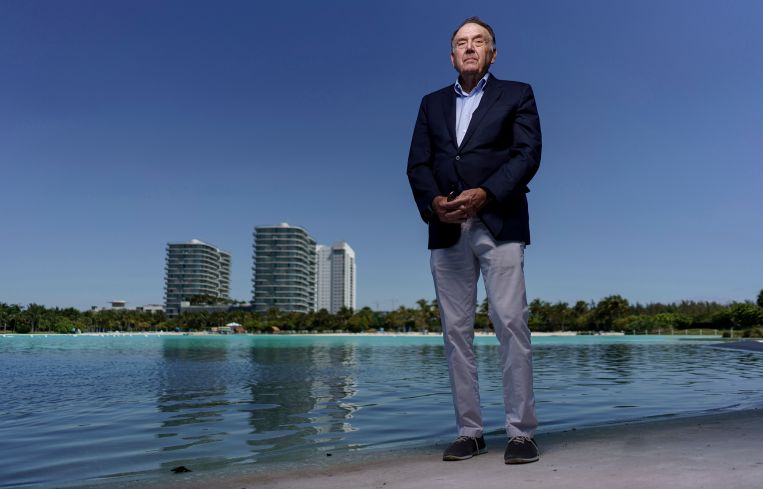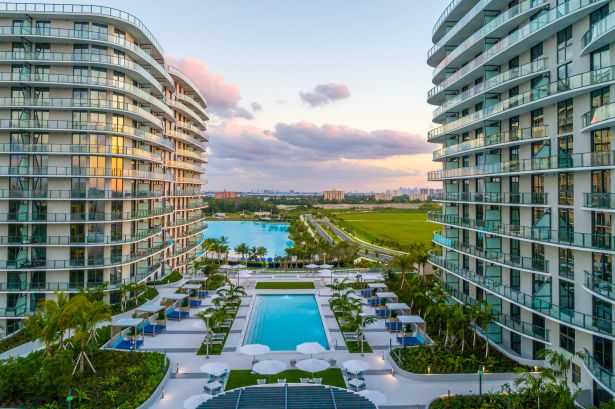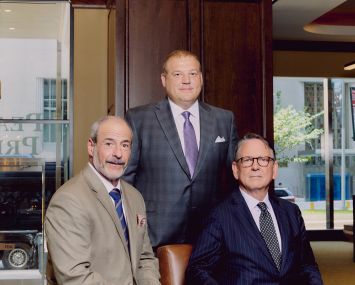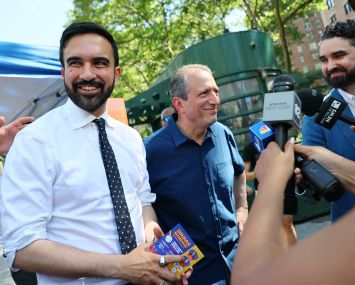New York’s Richard LeFrak Has Been Putting On a Clinic in Miami
His 185-acre SoLé Mia in North Miami aims to recreate some of the successes enjoyed in New Jersey and New York

Richard LeFrak is standing on the back deck of the leasing office of his North Miami project. He is gazing out at a clear blue, 7-acre lagoon. His eyes have some of the same sparkle as the water.
“Did you ever see an amenity like that?”
The septuagenarian (he will turn 80 this year) looks as happy and full of wonder as a child.
The crystal lagoon is the centerpiece of SoLé Mia. LeFrak spent about $20 million on the lagoon (and millions more maintaining it every year) at the multibillion-dollar project his namesake company has been working on for the past 13 years. It’s as ambitious as anything in his portfolio.
That’s saying something. This mandarin of real estate (Richard LeFrak is the third in the storied four-generation family firm) built and bought many thousands of apartments in New York, New Jersey, Los Angeles, Seattle, San Francisco and Florida — about 20,000 total by last count.
But SoLé Mia feels different. At least the way LeFrak talks about it.
The lagoon (the brainchild of one of his employees who had seen something similar in Cabo San Lucas) is just one piece of the vision. With Jackie Soffer’s Turnberry Associates, LeFrak is building out some 5,000 apartments and condominiums. (The condos are the purview of Turnberry, a hugely respected developer and manager in the region; the first condo building is a year from completion and 75 percent sold.)
The residences come equipped with lounges, cafes, clubs, padel tennis courts (it’s Reserve Padel’s first permanent location), podcast studios, yoga studios, coworking spaces, and gleaming, well-maintained gyms.

As one spreads out from the residences, the majority of which are still under construction, there’s a health care center that’s being built by the University of Miami; a kindergarten-through-fifth charter school; a Costco (and there’s a nearby Publix not technically connected to SoLé Mia); a Warren Henry car dealership that sells Range Rovers, Jaguars and Infinitis; and a Porsche dealership under construction. There’s typically a two-hour wait at Sesame Bakery on the weekends. It’s as much a metropolis as it is development, then. And all in the middle of a South Florida market that is desperate for more multifamily.
In this sense LeFrak is keeping with the kinds of projects he and his family are famous for. LeFrak City in Queens, which was developed by his father Samuel, consists of some 4,600 apartments sprawled over 20 buildings. The LeFraks tried this trick again in the 1980s when they found a largely abandoned piece of land in Jersey City and decided to get to work on their Newport development.
“Jersey City was kind of sketchy in the `80s,” LeFrak said. “It wasn’t cool … but it was a chance to just [take] a big piece of land and make your own community and create your own identification.”
Four decades later, LeFrak is still churning out housing at Newport, last year unveiling the 385-unit Bisby.
SoLé Mia is still in its childhood by way of comparison. The name sounds like a Spanish phrase — meaning “my sunshine” perhaps? — but it’s not. The “So” is for Jackie Soffer. The “Lé” is for LeFrak. The “Mia” is Miami. (We can’t say where the odd flat accent over the “e” came from, but we’ll just go with it.)
“We’ve taken on these big projects — which we can do because we don’t have outside capital,” LeFrak told Commercial Observer. “I’m not satisfying a sovereign wealth fund, or a private equity fund [worrying about] when is a liquidating event? When am I getting my money back? What’s my IRR? I don’t have those constraints.”
LeFrak wasn’t necessarily planning to get involved in Florida real estate, but during the Global Financial Crisis he was still very liquid and got the opportunity to invest in the failed BankUnited, which was headquartered in Miami-Dade County. He started coming down to the area for board meetings. Shortly thereafter he got the opportunity to buy the distressed assets of Chicago-based Corus Bank with Starwood. As part of that deal, LeFrak got a close look at the 2,000 or so Miami condominiums that were in some state of distress in the Corus portfolio, and began to really learn the market.
“I remember this vividly during the financial crisis,” said Merrimac Ventures’ Nitin Motwani, who has since partnered with LeFrak on two projects in Flagler Village, a neighborhood in Fort Lauderdale. Motwani was in the sales office for one of his projects when a salesman for one of the Corus properties came bounding in.
“He said, ‘I just met Richard LeFrak.’
“I said, ‘What are you talking about?’
“ ‘He walked into the sales office and was asking questions.’ ”
LeFrak wasn’t interested in getting a distilled picture of the property. And he wasn’t traveling with an entourage. (It took the salesman a little while to figure out who LeFrak was.) “He could have any broker, any banker — anyone would come with him. But he wanted to see for himself. And he didn’t do that just in that building. He did it with everything in the portfolio.”
As he was dipping his toes in Miami, LeFrak also got a sense that many of his peers were misreading the market. While South Florida has always been a tale of booms and busts, LeFrak figured out something that others didn’t know: Miami actually had a poor pipeline. While his peers were saying that there was a 20-year supply of condos and multifamily, LeFrak disagreed.

“The people from Latin America were inhaling these things — I mean just inhaling these,” LeFrak said. He told his sons Harrison and Jamie, currently principals at the firm, that the Miami market was actually undersupplied. Instead of 20 years, the inventory would be scooped up in three.
That didn’t mean LeFrak — despite the vast experience the family had in construction — quite knew the ins and outs of South Florida in particular. Which is why they hooked up with Turnberry.
“If you really look at his moves — all his big moves [in South Florida] have been in conjunction with a local partner,” said 13th Floor Investments’ Arnaud Karsenti, who has partnered with LeFrak on several property deals. “That’s very clever. … A lot of people come down and think they can do it all themselves — or look at it transactionally. Richard is planting a seed. He’s figuring out ‘How much can I grow that plant? Is this something that’s going to last generations?’ ”
Turnberry had been interested in the property that would become SoLé Mia. And, while LeFrak didn’t want to sell, he also recognized that the Soffers — another storied real estate family who essentially forged nearby Aventura — were connected to the local people needed to get the thing off the ground. Hence, the partnership.
As they started working together, Jackie Soffer began seeing echos of what her father did in Aventura — i.e. building a lagoon in the center of the SoLé Mia campus, just as a golf course had been the focal point of Aventura, regardless of whether the majority of people played golf.
“I watched what my father did, and SoLé Mia is a mini-Aventura — we’ve got the [Oleta River State] Park, the ocean views, we’ve got access to food and beverage,” said Soffer. It was a perfect balance of location and opportunity.
SoLé Mia is already an extremely long way from where it was when LeFrak showed up at the auction for the infill property called Biscayne Landing more than a decade ago.
“Another developer had failed with it,” LeFrak said. “There’s a long history with this property that goes back to the `50s and `60s. A million guys tried. They were going to make a world’s fair here, and they were going to make a sports center here.”
The previous owners — Boca Developers — were reeling from the Global Financial Crisis and abandoned their plans for a mixed-use project.
“The city and the lender walked away, because what are they going to do with it?” LeFrak said.
When the auction was finally scheduled, nobody showed up except LeFrak.
Moreover, the price he agreed to for this swath of 184 acres of North Miami infill between Biscayne Boulevard and Biscayne Bay, south of Aventura, was around $21 million — less than certain condos now go for nearby. (“Don’t jump at that,” LeFrak warned. “It was a ground lease — so I had to negotiate with the city to get fee title to some of it. And there were some environmental issues I had to cope with.” But still!)
“The guy who brought me the project and showed it to me originally, his idea was to put a big-box shopping center on it,” LeFrak said with a bemused grin. “That was his design. He had a million-foot, big-box shopping center. Which is nothing like what we’re doing here.”
The next decade involved moving a million cubic yards of dirt, building roads to the site, and spending hundreds of millions of dollars in environmental, infrastructure and master-
planning costs.
Of course, LeFrak is far from finished. The project is approximately 20 percent completed. He estimates it will be another 15 years or so of development before the dream is fully realized. But, then, the LeFrak family has always enjoyed that critical combination of patience and boldness when it came to their real estate development. Back in 1982, when LeFrak and his father began seriously considering the project that would become Newport in Jersey City, LeFrak started mentally tallying what the project would cost.
This thing’s going to cost $4 billion, LeFrak noted to his father. Where are we going to get the money?
His father’s answer was a sanguine, Don’t worry, we’ll get it.
“That’s an optimist,” LeFrak said. “You’ve got to be all these things — you have to have a vision, you have to be an optimist, you have to work your way through it.”
But that’s the way it played out for LeFrak in New Jersey — and South Florida.
“If I didn’t love what we were doing, I wouldn’t do it. There’s a huge emotional dividend.”
Max Gross can be reached at mgross@commercialobserver.com.


